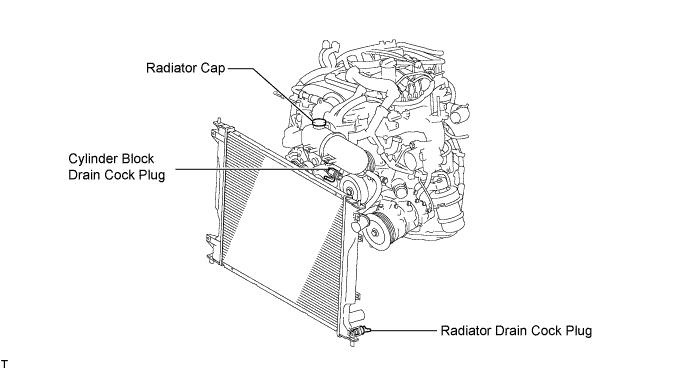Lexus IS250 IS220d GSE20 ALE20 2AD-FHV COOLING
COOLANT - ON-VEHICLE INSPECTION
| 1. REMOVE ENGINE UNDER COVER |
| 2. DRAIN ENGINE COOLANT |
- CAUTION:
- Do not remove the radiator cap while the engine and radiator are still hot. Pressurized, hot engine coolant and steam may be released and cause serious burns.
Remove the radiator cap.
Loosen the radiator drain cock plug and cylinder block drain cock plug. Then drain the coolant.

- HINT:
- Collect the coolant in a container and dispose of it according to local regulations.
| 3. ADD ENGINE COOLANT |
Tighten all the plugs.
- Torque:
- for cylinder block drain cock plug:
- 20 N*m{ 204 kgf*cm, 15 ft.*lbf}
Add engine coolant.
- Specified capacity:
- 8.9 liters (9.4 US qts, 7.8 lmp. qts)
- HINT:
Slowly pour coolant into the radiator reservoir until it reaches the FULL line.
Squeeze the inlet and outlet radiator hoses several times by hand, and then check the level of the coolant.
If the coolant level is low, add coolant.
Install the radiator cap.
Bleed air from the cooling system.
- NOTICE:
- Before starting the engine, turn the A/C switch off.
Warm up the engine until the thermostat opens. While the thermostat is open, allow the coolant to circulate for several minutes.
- HINT:
- The thermostat open timing can be confirmed by squeezing the inlet radiator hose by hand, and sensing vibrations when the engine coolant starts to flow inside the hose.
- NOTICE:
- When squeezing the radiator hose:
Maintain the engine speed at 2,000 to 2,500 rpm.
Squeeze the inlet and outlet radiator hoses several times by hand to bleed air from the system.
- NOTICE:
- When squeezing the radiator hoses:
Stop the engine and wait until the engine coolant cools down to ambient temperature.
- CAUTION:
- Do not remove the radiator cap while the engine and radiator are still hot. Pressurized, hot engine coolant and steam may be released and cause serious burns.

Check the coolant level in the reserve tank.
If the coolant level is low, add coolant to the reserve tank FULL line.
| 4. CHECK FOR ENGINE COOLANT LEAKAGE |
- CAUTION:
- Do not remove the radiator cap while the engine and radiator are still hot. Pressurized, hot engine coolant and steam may be released and cause serious burns.
- NOTICE:
- Before performing each inspection, turn the A/C switch off.

Fill the radiator with coolant and attach a radiator cap tester.
Warm up the engine.
Using a radiator cap tester, increase the pressure inside the radiator to 177 kPa (1.8 kgf/cm, 26 psi), and check that the pressure does not drop.
If the pressure drops, check the hoses, radiator and water pump for leaks. If no external leaks are found, check the heater core, cylinder block and cylinder head.
| 5. INSTALL ENGINE UNDER COVER |